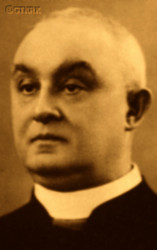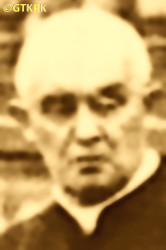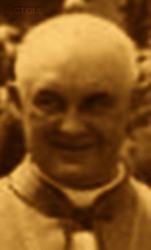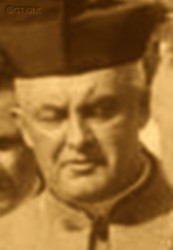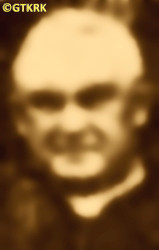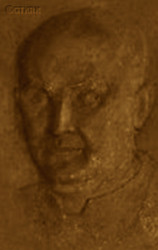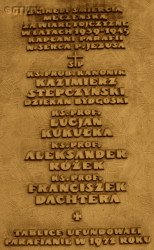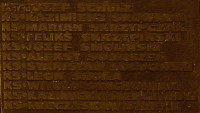Roman Catholic
St Sigismund parish
05-507 Słomczyn
85 Wiślana Str.
Konstancin deanery
Warsaw archdiocese, Poland
full list:
displayClick to display full list

searchClick to search full list by categories
wyświetlKliknij by wyświetlić pełną listę po polsku

szukajKliknij by przeszukać listę wg kategorii po polsku

Martyrology of the clergy — Poland
XX century (1914 – 1989)
personal data
surname
STEPCZYŃSKI
surname
versions/aliases
STĘPCZYŃSKI
forename(s)
Casimir (pl. Kazimierz)
function
diocesan priest
creed
Latin (Roman Catholic) Church RCmore on
en.wikipedia.org
[access: 2014.09.21]
diocese / province
Gniezno and Poznań archdiocese (aeque principaliter)more on
www.archpoznan.pl
[access: 2012.11.23]
RC Military Ordinariate of Polandmore on
en.wikipedia.org
[access: 2014.12.20]
honorary titles
honorary canonmore on
en.wikipedia.org
[access: 2014.11.14]
(1932, Assumption of the Blessed Virgin Mary RC archcathedral church, Gnieznotoday: Gniezno urban gm., Gniezno pov., Greater Poland voiv., Poland
more on
en.wikipedia.org
[access: 2021.12.18])
Ad Honores Spiritual Counselor
(c. 1925)
date and place
of death
31.10.1939

Bydgoszcztoday: Bydgoszcz city pov., Kuyavia‐Pomerania voiv., Poland
more on
en.wikipedia.org
[access: 2021.06.20]
alt. dates and places
of death
03.11.1939
n. Bydgoszcztoday: Bydgoszcz pov., Kuyavia‐Pomerania voiv., Poland
more on
en.wikipedia.org
[access: 2021.06.20]
details of death
In Prussian times — in the Prussian partition of Poland — being a vicar in Połajewo, in 1908 — as a member of the Polish Electoral Committee in the Germ. Kreis Obornik (Eng. Oborniki county), a part of the Germ. Provinz Posen (Eng. Province of Poznań) — led an election campaign for a Polish candidate before the elections to the Germ. Preußischer Landtag (Eng. Prussian Representative Assembly). Participation in elections in the lands of Prussian partition of Poland was significantly higher than in other regions of Prussia, e.g. in the Germ. Kreis Obornik amounted to 77%. Similarly, later, during his ministry in the Ryczywół parish, continued to be active in the local election committee — in 1912, elections were held to the Germ. Reichstag (Eng. Reich Parliament) of the German Empire, and in 1913 again to the Germ. Preußischer Landtag.
After the abdication on 09.11.1918 of the German Emperor William II Hohenzollern; after the signing on 11.11.1918 by the Allies and the Germans, in the staff wagon in Compiègne, at the headquarters of French Marshal Ferdinand Foch, of the armistice and ceasefire — which de facto meant the end of World War I; and also after the handover on 11.11.1918 by the Regency Council – operating in the so‐called Germ. Königreich Polen (Eng. Polish Kingdom) occupied by the Central Powers (Germany and Austria–Hungary) — of supreme command over the army to Brigadier Joseph Piłsudski and his appointment as Commander‐in‐Chief of the Polish Army, which de facto meant the rebirth of the Polish state, encompassing however only the Germ. Königreich Polen, i.e. the Polish territory under Russian rule until 1915, but excluding the lands of the Prussian partition; Greater Poland — as the Prussian German Provinz Posen — was still formally part of the German state. In his Ryczywół parish, as in many other towns in Greater Poland, a kind of dual power system was formed. The Germans gathered around the Germ. Soldatenrat (Eng. Soldiers' Council) RŻ, based on soldiers of the former Imperial Army; the Poles in the People's Council RL, formed at the appeal of the Polish Supreme People's Council from Poznań, established on the basis of the former clandestine Inter‐Party Committee, which supported the Allies during the war (which was of course a betrayal of the German state). Became the president of the latter and a delegate to the County People's Council PRL, established in Oborniki, whose first meeting was held on 29.11.1918.
This situation could not last long, and on 27.12.1918 the Greater Poland Uprising broke out. Became involved in the preparations for take over of the power in Ryczywół by the Poles. Clandestine meetings of the insurgents were organized in his rectory, where the strategy of action was discussed. Early on the Poles captured the two largest towns in the county: Rogoźno on 01.01.1920, and Oborniki on 04.01.1920. In order to take over power in Ryczywół, went to Rogoźno and from there brought a company consisting of insurgents from Rogoźno and Budzyń. It entered Ryczywół on 06.01.1920 — a truck drove into the market square with the inscription „Join the insurgent ranks!”, after which the post office, the city hall and the railway station were taken over. After negotiations with the German RŻ, the Germans were disarmed. In the next step, prob. the Ryczywół insurgent company was formed and took part in battles with the Germans along the Noteć River, i.a. for Chodzież and Czarnków. In some register is listed as its chaplain.
The Uprising ended on 16.02.1919 with a truce in Trier, enforced by the victorious Entente states, under which the Polish insurgent Greater Poland Army was recognized as an allied army and a border was set, which „German troops were forbidden to cross”, leaving a large part of Greater Poland outside their influence. However, it was not until the Treaty of Versailles, concluded on 28.06.1919, that Greater Poland, including Ryczywół, was formally awarded to Poland. Officially it became part of Poland on 10.01.1920, after the ratification of the treaty by all contracting parties.
After German invasion of Poland on 01.09.1939 (Russians invaded Poland 17 days later) and start of the World War II, arrested by the Germans on 08.09.1939, three days after Bydgoszcz capture.
Jailed in IL Bromberg internment camp.
On 09.09.1939, brought to the Old Market Square in Bydgoszcz, where was forced to observe the execution of 20 Poles by German Wehrmacht soldiers. Before the execution, the victims were beaten with rifle butts, forced to fall and get up, and stand for hours with their hands raised.
Maltreated and tortured.
Between 31.10 and 3.11.1939 taken out — together with a group of Poles — in a truck in an unknown direction and murdered.
In 1939, Bydgoszcz became a place of particular German repressions. Even before their invasion, the Germans on 03‐04.09.1939 organized a provocation in Bydgoszcz, during which Germ. Volksdeutsche (Eng. Ethnic Germans), i.e. representatives of the German minority in Poland, began shooting Polish soldiers defending Bydgoszcz in the back. The Poles suppressed the rebellion, prob. i.a. by executing many German traitors. The Germans exploited these events for propaganda purposes, calling them the Germ. „Bromberger Blutsonntag” (Eng. „Bydgoszcz Bloody Sunday”). After capturing the city on 05.09.1939, the Germans began bloody repressions against Poles. The Germ. Wehrmacht (Eng. Armed Forces), appointed by the Germ. 4. Armee (Eng. 4th Army), which captured Bydgoszcz, the commander of Bydgoszcz, Major General Walter Braemer, issued on 08.09.1939 an order, to cleanse the city of „criminal Polish elements”. The Germans began searching private homes, apartment by apartment. If weapons, e.g., souvenir sabres, etc., were found, the occupants were shot on the spot. Several public executions were also carried out.
The action was carried out by soldiers of the Germ. Wehrmacht and the genocidal Germ. Einsatzkommando 1/IV (Eng. 1/IV Task Group), part of the Germ. Einsatzgruppen (Eng. Operational Groups), a formation of the Germ. Sicherheitspolizei (Eng. Security Police), i.e. SiPo, and the Germ. Sicherheitsdienst des Reichsführers SS (Eng. Security Service of the Reichsführer SS), i.e. SD, subordinated to the Germ. Reichsicherheitshauptamt (Eng. Reich Main Security Office), i.e. RSHA, operating behind the German 4th Armee.
The repressions then turned into an organized extermination action — as part of the Germ. «Intelligenzaktion» (Eng. Intelligence Action), i.e. the extermination of the Polish intelligentsia and the leadership classes of Pomerania, based on the so‐called Germ. Sonderfahndungsliste (Eng. Special Wanted List), i.e. a proscription list of names of „enemies of the Reich”, prepared before the German aggression, or on some other proscription list, drawn up ad hoc on denunciations from local Germ. Volksdeutsche.
It was carried out by units of the genocidal Germ. Volksdeutscher Selbstschutz (Eng. Ethnic German Self‐Defense), whose members were Germ. Volksdeutsche from Bydgoszcz and the surrounding area, supervised by the paramilitary, genocidal Germ. Die Schutzstaffel der NSDAP (Eng. NSDAP Protection Unit), i.e. «SS», subordinate to the National Socialist German Workers' Party NSDAP, and supported by the Germ. Ordnungspolizei (Eng. Order Police), i.e. OrPo, a formation directly subordinated to the Germ. Chef der Deutschen Polizei (Eng. Chief of the German Police), the genocide master Heinrich Himmler. By the end of 1939, the Germans had murdered c. 5,000 Poles in public and hidden executions — many in nearby forests — including c. 1,500‐1,900 from Bydgoszcz alone.
Arrested Poles, after initial interrogations, were held mainly in the IL Bromberg internment camp, established on the premises of the barracks of the Polish 15th Light Artillery Regiment at 147 Gdańska Street. From there, were transported to the execution site or to concentration camps. In 09.1939 alone, c. 3,500 Poles (approximately 2.5% of Bydgoszcz's Polish residents) passed through the camp.
cause of death
mass murder
perpetrators
Germans
sites and events
FordonClick to display the description, TryszczynClick to display the description, Gdański forestClick to display the description, IL BrombergClick to display the description, «Intelligenzaktion»Click to display the description, Reichsgau Danzig‐WestpreußenClick to display the description, Ribbentrop‐MolotovClick to display the description, Pius XI's encyclicalsClick to display the description, Greater Poland UprisingClick to display the description
date and place
of birth
04.03.1881

Żydowotoday: Rokietnica gm., Poznań pov., Greater Poland voiv., Poland
more on
en.wikipedia.org
[access: 2021.07.18]
parents
STEPCZYŃSKI Stanislav
🞲 ?, ? — 🕆 ?, ?

POTRZEBOWSKA Antonina
🞲 ?, ? — 🕆 ?, ?
presbyter (holy orders)
ordination
11.02.1906

Gnieznotoday: Gniezno urban gm., Gniezno pov., Greater Poland voiv., Poland
more on
en.wikipedia.org
[access: 2021.12.18]
positions held
1929 – 1939
dean — Bydgoszcztoday: Bydgoszcz city pov., Kuyavia‐Pomerania voiv., Poland
more on
en.wikipedia.org
[access: 2021.06.20] RC deanery
1925 – 1939
parish priest — Bydgoszcztoday: Bydgoszcz city pov., Kuyavia‐Pomerania voiv., Poland
more on
en.wikipedia.org
[access: 2021.06.20] ⋄ Sacred Heart of Jesus RC parish ⋄ Bydgoszcz‐citydeanery name
today: Bydgoszcz city pov., Kuyavia‐Pomerania voiv., Poland
more on
en.wikipedia.org
[access: 2021.06.20] RC deanery — also: c. 1930‐1939 Archbishop's delegate at secondary levels i.e. matura exams in teachers' seminaries / pedagogical lyceums for Bydgoszcz; c. 1929‐1939 inspector of religious education in primary schools in Bydgoszcz county/deanery; c. 1927‐1929 deanery assessor I, i.e. dean's assistant in the office, in particular in congregational activities; chaplain of the vacant military parish in Bydgoszcz; member and in c. 1935 president of the Charles Marcinkowski Scientific Aid Society Committee for the city of Bydgoszcz
1930 – 1933
pro‐synodal judge — Gnieznotoday: Gniezno urban gm., Gniezno pov., Greater Poland voiv., Poland
more on
en.wikipedia.org
[access: 2021.12.18] ⋄ Archbishop's Metropolitan Court ⋄ Gniezno RC archdiocese
1919 – 1925
dean — Obornikitoday: Oborniki gm., Oborniki pov., Greater Poland voiv., Poland
more on
en.wikipedia.org
[access: 2020.11.27] RC deanery
1918 – 1919
deputy dean — Obornikitoday: Oborniki gm., Oborniki pov., Greater Poland voiv., Poland
more on
en.wikipedia.org
[access: 2020.11.27] RC deanery
1912 – 1925
parish priest — Ryczywółtoday: Ryczywół gm., Oborniki pov., Greater Poland voiv., Poland
more on
en.wikipedia.org
[access: 2022.08.05] ⋄ St Nicholas the Bishop and Confessor RC parish ⋄ Obornikitoday: Oborniki gm., Oborniki pov., Greater Poland voiv., Poland
more on
en.wikipedia.org
[access: 2020.11.27] RC deanery — church builder; also: president of the Farming Group; 1922‐1925 vice‐president of the Supervisory Board of the People's Bank; from 1917 member of the „Caritas” Charity Union
1912
administrator — Ryczywółtoday: Ryczywół gm., Oborniki pov., Greater Poland voiv., Poland
more on
en.wikipedia.org
[access: 2022.08.05] ⋄ St Nicholas the Bishop and Confessor RC parish ⋄ Obornikitoday: Oborniki gm., Oborniki pov., Greater Poland voiv., Poland
more on
en.wikipedia.org
[access: 2020.11.27] RC deanery
1912
curatus/rector/expositus — Wyszynytoday: Budzyń gm., Chodzież pov., Greater Poland voiv., Poland
more on
en.wikipedia.org
[access: 2021.12.18] ⋄ Blessed Virgin Mary of Consolation RC church ⋄ Ryczywółtoday: Ryczywół gm., Oborniki pov., Greater Poland voiv., Poland
more on
en.wikipedia.org
[access: 2022.08.05], St Nicholas the Bishop and Confessor RC parish ⋄ Obornikitoday: Oborniki gm., Oborniki pov., Greater Poland voiv., Poland
more on
en.wikipedia.org
[access: 2020.11.27] RC deanery
1911 – 1912
vicar — Śmigieltoday: Śmigiel gm., Kościan pov., Greater Poland voiv., Poland
more on
en.wikipedia.org
[access: 2021.07.18] ⋄ Assumption of the Blessed Virgin Mary RC parish ⋄ Śmigieltoday: Śmigiel gm., Kościan pov., Greater Poland voiv., Poland
more on
en.wikipedia.org
[access: 2021.07.18] RC deanery
1911
administrator — Twardówtoday: Kotlin gm., Jarocin pov., Greater Poland voiv., Poland
more on
en.wikipedia.org
[access: 2022.07.16] ⋄ St Peter and St Paul the Apostles RC parish ⋄ Pleszewtoday: Pleszew gm., Pleszew pov., Greater Poland voiv., Poland
more on
en.wikipedia.org
[access: 2021.05.30] RC deanery
1911
administrator — Witaszycetoday: Jarocin gm., Jarocin pov., Greater Poland voiv., Poland
more on
en.wikipedia.org
[access: 2021.07.18] ⋄ Holy Trinity RC parish ⋄ Nowe Miasto nad Wartątoday: Nowe Miasto nad Wartą gm., Środa Wielkopolska pov., Greater Poland voiv., Poland
more on
en.wikipedia.org
[access: 2020.11.27] RC deanery
1906 – 1911
vicar — Połajewotoday: Połajewo gm., Czarnków/Trzcianka pov., Greater Poland voiv., Poland
more on
en.wikipedia.org
[access: 2021.07.18] ⋄ St Michael the Archangel RC parish ⋄ Czarnkówtoday: Czarnków gm., Czarnków/Trzcianka pov., Greater Poland voiv., Poland
more on
en.wikipedia.org
[access: 2021.06.20] RC deanery — also: from 1907 member of the Union of Polish–Catholic Charitable Societies
till 1906
student — Gnieznotoday: Gniezno urban gm., Gniezno pov., Greater Poland voiv., Poland
more on
en.wikipedia.org
[access: 2021.12.18] ⋄ philosophy and theology, Archbishop's Practical Theological Seminary (Lat. Seminarium Clericorum Practicum)
from 1902
student — Poznańtoday: Poznań city pov., Greater Poland voiv., Poland
more on
en.wikipedia.org
[access: 2021.07.18] ⋄ philosophy and theology, Archbishop's Theological Seminary (Collegium Leoninum)
from 1916
membership — Poznańtoday: Poznań city pov., Greater Poland voiv., Poland
more on
en.wikipedia.org
[access: 2021.07.18] ⋄ Friends of Sciences Society
others related
in death
GRUCHAŁAClick to display biography Edmund, JAKUBOWSKIClick to display biography John, KOŹLIKClick to display biography Stanislav, KUKUŁKAClick to display biography Lucyn, LEWICKIClick to display biography Anthony Severin, ROŻEKClick to display biography Alexander, SZAREKClick to display biography Peter, WAGNERClick to display biography John Francis, WIOREKClick to display biography Stanislav, WOJCIECHOWSKIClick to display biography Ceslav Adalbert
sites and events
descriptions
Fordon: In the „Valley of Death” in Fordon, where from 10.10.1939 till 11.11.1939 Germans murdered — as a part of «Intelligenzaktion» aimed at extermination of Polish intelligentsia and ruling classes in Pomerania — 1,200‐3,000 Poles from Bydgoszcz, mainly from intelligentsia. (more on: pl.wikipedia.orgClick to attempt to display webpage
[access: 2012.11.23])
Tryszczyn: In the vicinity of Tryszczyn (10 km from Bydgoszcz) Germans — as a part of «Intelligenzaktion» aimed at extermination of Polish intelligentsia and ruling classes in Pomerania — murdered from 09.1939 till 10.1939 approx. 900 inhabitants of Bydgoszcz and surrounding villages. (more on: pl.wikipedia.orgClick to attempt to display webpage
[access: 2021.12.19])
Gdański forest: Location, near Bydgoszcz, where Germans, during «Intelligenzaktion» — extermination of Polish intelligentsia program — murdered a score of Poles. (more on: pl.wikipedia.orgClick to attempt to display webpage
[access: 2012.11.23])
IL Bromberg: Germ. „Internierungslager” (Eng. „Internment camp”) set up on 05.09.1939 — the day Germans took over Bydgoszcz — in 15 Greater Poland Light Artillery Regiment military barracks at 147 Gdańska Str. in Bydgoszcz. In 09.1939 only c. 3,500 Poles were jailed there. Prisoners were held in f. stables or f. armory building. They were maltreated and tortured. Some were shot on the spot (c. 28 victims in 09.1939). Next they were sent to concentration camps throughout Germany. Some were taken to mass execution sites in nearby forests and murdered. On 01.11.1939 the camp was moved to f. ammunition warehouses in Jachcice town district. The camp was closed in 12.1939. (more on: pl.wikipedia.orgClick to attempt to display webpage
[access: 2015.09.30])
«Intelligenzaktion»: German: «Intelligenzaktion» (English: „Intelligence Action”) — a German program of extermination of the Polish elite, mainly the intelligentsia and leadership layers, carried out from the beginning of the occupation in w 09.1939 to 04.1940, mainly in territories directly annexed to Germany, but also in the so‐called Germ. Generalgouvernement (Eng. General Governorate), where it was called «AB‐aktion». In the first phase, immediately after the beginning of the German occupation, during military operations carried out by the Germ. Wehrmacht (Eng. Armed Forces) and the genocidal units of the Germ. Einsatzgruppen (Eng. Operational Groups) of the Germ. Sicherheitspolizei (Eng. Security Police), i.e. SiPo, and Germ. Sicherheitsdienst des Reichsführers SS (Eng. Security Service of the Reichsführer SS), i.e. SD, organized by the Germ. Reichssicherheitshauptamt (Eng. Reich Main Security Office), i.e. RSHA, which followed the troops, carried out under the Germ. Unternehmen „Tannenberg” (Eng. Operation „Tannenberg”) — based on the so‐called Germ. Sonderfahndungsliste (Eng. Special Wanted Lists), i.e. proscription lists of Poles considered particularly dangerous to the Third Reich, prepared by the Zentralstelle II/P (Polen) unit of the German RSHA. Later, implemented by the German civilian occupation authorities and the genocidal unit of the Germ. Volksdeutscher Selbstschutz (Eng. Ethnic Germans Self‐Defense), whose members were Germ. Volksdeutsche (Eng. Ethnic Germans), i.e. representatives of the German minority in Poland. According to various sources, these lists, at the beginning of 09.1939, could have contained the details of 61,000—88,000 „dangerous” Poles — although these figures cannot be confirmed. In total, during this genocide, c. 50,000 teachers, Catholic priests, representatives of the landed gentry, freelancers, social and political activists, and retired military personnel were systematically and methodically murdered. Another 50,000 were sent to concentration camps, where only a negligible percentage survived. (more on: en.wikipedia.orgClick to attempt to display webpage
[access: 2014.10.04])
Reichsgau Danzig‐Westpreußen: After the Polish defeat in the 09.1939 campaign, which was the result of the Ribbentrop‐Molotov Pact and constituted the first stage of World War II, and the beginning of German occupation in part of Poland (in the other, eastern part of Poland, the Russian occupation began), the Germans divided the occupied Polish territory into five main regions (and a few smaller). The largest one was transformed into Germ. Generalgouvernement (Eng. General Governorate), intended exclusively for Poles and Jews and constituting part of the so‐called Germ. Großdeutschland (Eng. Greater Germany). Two were added to existing German provinces. From two other separate new provinces were created. Vistula Pomerania region was one of them, incorporated into Germany on 08.10.1939, by decree of the German leader Adolf Hitler (formally came into force on 26.10.1939), and on 02.11.1939 transformed into the Germ. Reichsgau Danzig‐Westpreußen (Eng. Reich District of Gdańsk‐West Prussia) province, in which the law of the German state was to apply. The main axis of the policy of the new province, the territory of which the Germans recognized as the Germ. „Ursprünglich Deutsche” (Eng. „natively German”), despite the fact that 85% of its inhabitants were Poles, was Germ. „Entpolonisierung” (Eng. „Depolonisation”), i.e. forced Germanization. C. 60,000 Poles were murdered in 1939‐1940, as part of the Germ. „Intelligenzaktion”, i.e. extermination of Polish intelligentsia and ruling classes, in c. 432 places of mass executions — including c. 220 Polish Catholic priests. The same number were sent to German concentration camps, from where few returned (over 300 priests were arrested, of whom c. 130 died in concentration camps). C. 124,000‐170,000 were displaced, including c. 90,000 to the Germ. Generalgouvernement. Poles were forced en masse to sign the German nationality list, the Germ. Deutsche Volksliste DVL. Polish children could only learn in German. It was forbidden to use the Polish language during Catholic Holy Masses and during confession. Polish landed estates were confiscated..To further reduce the number of the Polish population, Poles were sent to forced labor deep inside Germany. The remaining Poles were treated as low‐skilled labor, isolated from the Germans and strictly controlled — legally, three or three of them could only meet together, even in their own apartments. Many were conscripted into the German Wehrmacht army. After the end of hostilities of World War II, the overseer of this province, the Germ. Reichsstatthalter (Eng. Reich Governor) and the Germ. Gauleiter (Eng. district head) of the German National Socialist Party, Albert Maria Forster, was executed. (more on: en.wikipedia.orgClick to attempt to display webpage
[access: 2024.06.24])
Ribbentrop‐Molotov: Genocidal Russian‐German alliance pact between Russian leader Joseph Stalin and German leader Adolf Hitler signed on 23.08.1939 in Moscow by respective foreign ministers, Mr. Vyacheslav Molotov for Russia and Joachim von Ribbentrop for Germany. The pact sanctioned and was the direct cause of joint Russian and German invasion of Poland and the outbreak of the World War II in 09.1939. In a political sense, the pact was an attempt to restore the status quo ante before 1914, with one exception, namely the „commercial” exchange of the so‐called „Kingdom of Poland”, which in 1914 was part of the Russian Empire, fore Eastern Galicia (today's western Ukraine), in 1914 belonging to the Austro‐Hungarian Empire. Galicia, including Lviv, was to be taken over by the Russians, the „Kingdom of Poland” — under the name of the General Governorate — Germany. The resultant „war was one of the greatest calamities and dramas of humanity in history, for two atheistic and anti‐Christian ideologies — national and international socialism — rejected God and His fifth Decalogue commandment: Thou shall not kill!” (Abp Stanislav Gądecki, 01.09.2019). The decisions taken — backed up by the betrayal of the formal allies of Poland, France and Germany, which on 12.09.1939, at a joint conference in Abbeville, decided not to provide aid to attacked Poland and not to take military action against Germany (a clear breach of treaty obligations with Poland) — were on 28.09.1939 slightly altered and made more precise when a treaty on „German‐Russian boundaries and friendship” was agreed by the same murderous signatories. One of its findings was establishment of spheres of influence in Central and Eastern Europe and in consequence IV partition of Poland. In one of its secret annexes agreed, that: „the Signatories will not tolerate on its respective territories any Polish propaganda that affects the territory of the other Side. On their respective territories they will suppress all such propaganda and inform each other of the measures taken to accomplish it”. The agreements resulted in a series of meeting between two genocidal organization representing both sides — German Gestapo and Russian NKVD when coordination of efforts to exterminate Polish intelligentsia and Polish leading classes (in Germany called «Intelligenzaktion», in Russia took the form of Katyń massacres) where discussed. Resulted in deaths of hundreds of thousands of Polish intelligentsia, including thousands of priests presented here, and tens of millions of ordinary people,. The results of this Russian‐German pact lasted till 1989 and are still in evidence even today. (more on: en.wikipedia.orgClick to attempt to display webpage
[access: 2015.09.30])
Pius XI's encyclicals: Facing the creation of two totalitarian systems in Europe, which seemed to compete with each other, though there were more similarities than contradictions between them, Pope Pius XI issued in 03.1937 (within 5 days) two encyclicals. In the „Mit brennender Sorge” (Eng. „With Burning Concern”) published on 14.03.1938, condemned the national socialism prevailing in Germany. The Pope wrote: „Whoever, following the old Germanic‐pre‐Christian beliefs, puts various impersonal fate in the place of a personal God, denies the wisdom of God and Providence […], whoever exalts earthly values: race or nation, or state, or state system, representatives of state power or other fundamental values of human society, […] and makes them the highest standard of all values, including religious ones, and idolizes them, this one […] is far from true faith in God and from a worldview corresponding to such faith”. On 19.03.1937, published „Divini Redemptoris” (Eng. „Divine Redeemer”), in which criticized Russian communism, dialectical materialism and the class struggle theory. The Pope wrote: „Communism deprives man of freedom, and therefore the spiritual basis of all life norms. It deprives the human person of all his dignity and any moral support with which he could resist the onslaught of blind passions […] This is the new gospel that Bolshevik and godless communism preaches as a message of salvation and redemption of humanity”… Pius XI demanded that the established human law be subjected to the natural law of God , recommended the implementation of the ideal of a Christian state and society, and called on Catholics to resist. Two years later, National Socialist Germany and Communist Russia came together and started World War II. (more on: www.vatican.vaClick to attempt to display webpage
[access: 2023.05.28], www.vatican.vaClick to attempt to display webpage
[access: 2023.05.28])
Greater Poland Uprising: Military insurrection of Poles of former German Germ. Posen Provinz (Eng. Poznań province) launched against German Reich in 1918‐1919 — after the abdication on 09.11.1918 of the German Emperor William II Hohenzollern; after the armistice between the Allies and Germany signed on 11.1.1918 in the HQ wagon in Compiègne, the headquarters of Marshal of France Ferdinand Foch — which de facto meant the end of World War I — against the German Weimar Republic, established on the ruins of the German Empire, aiming to incorporate lands captured by Prussia during partitions of Poland in XVIII century into Poland. The Republic of Poland, reborn on 11.11.1918, initially formally included only the so‐called Germ. Königreich Polen (Eng. Kingdom of Poland), i.e. the territory that had been under Russian rule until 1915 and then under the control of Central States (Germany and Austria–Hungary), but did not include the Prussian partition. Started on 27.12.1918 in Poznań and ended on 16.02.1919 with the armistice pact in Trier, forced by the victorious Entente states, which included provisions ordering Germany to cease operations against Poland and, importantly, recognizing the Polish insurgent Greater Poland Army as an allied armed force of the Entente. De facto it turned out to be a Polish victory, confirmed in the main peace treaty after World War I, the Treaty of Versailles of 28.06.1919, which came into force on 10.01.1920 and in which most of the lands of the Prussian partition were recognized as Polish. Many Polish priests took part in the Uprising, both as chaplains of the insurgents units and members and leaders of the Polish agencies and councils set up in the areas covered by the Uprising. In 1939 after German invasion of Poland and start of the World War II those priests were particularly persecuted by the Germans and majority of them were murdered. (more on: en.wikipedia.orgClick to attempt to display webpage
[access: 2016.08.14])
sources
personal:
www.filipini.poznan.plClick to attempt to display webpage
[access: 2012.11.23], www.wtg-gniazdo.orgClick to attempt to display webpage
[access: 2012.11.23], nspj.bydgoszcz.plClick to attempt to display webpage
[access: 2013.05.19], pl.wikipedia.orgClick to attempt to display webpage
[access: 2013.08.10], www.oborniki.com.plClick to attempt to display webpage
[access: 2015.09.30]
bibliographical:
„Martyrology of the Polish Roman Catholic clergy under nazi occupation in 1939‐1945”, Victor Jacewicz, John Woś, vol. I‐V, Warsaw Theological Academy, 1977‐1981
„Social Activist Priests in Greater Poland”, collective work, Biographical Dictionary, vol. 3 P‐S, Gniezno 2008
original images:
nspj.bydgoszcz.plClick to attempt to display webpage
[access: 2013.05.19], ww2.plClick to attempt to display webpage
[access: 2019.10.13], www.audiovis.nac.gov.plClick to attempt to display webpage
[access: 2015.09.30], www.audiovis.nac.gov.plClick to attempt to display webpage
[access: 2015.09.30], naszaprzeszlosc.plClick to attempt to display webpage
[access: 2019.10.13], www.wtg-gniazdo.orgClick to attempt to display webpage
[access: 2012.11.23], grant.zse.bydgoszcz.plClick to attempt to display webpage
[access: 2013.12.04], www.wtg-gniazdo.orgClick to attempt to display webpage
[access: 2012.11.23]
LETTER to CUSTODIAN/ADMINISTRATOR
If you have an Email client on your communicator/computer — such as Mozilla Thunderbird, Windows Mail or Microsoft Outlook, described at WikipediaPatrz:
en.wikipedia.org, among others — try the link below, please:
LETTER to CUSTODIAN/ADMINISTRATORClick and try to call your own Email client
If however you do not run such a client or the above link is not active please send an email to the Custodian/Administrator using your account — in your customary email/correspondence engine — at the following address:

giving the following as the subject:
MARTYROLOGY: STEPCZYŃSKI Casimir
To return to the biography press below:
 Click to return to biography
Click to return to biography








